KOLKATA MAA DURGA PUJA HISTORY
HISTORY OF DURGA PUJA
Durga Puja in Kolkata is more than a religious ritual – it is the heartbeat of the city, where devotion meets creativity and tradition blends with innovation. Its journey from intimate household ceremonies to today’s grand carnival reflects Bengal’s cultural evolution.
Early Beginnings (16th–17th Century):
The roots of Durga Puja in Bengal can be traced back to the late medieval period, when wealthy zamindar families and merchants began organizing the festival within their estates. These early pujas were private affairs, celebrated with traditional rituals and family gatherings.
18th Century – Rise of Household Pujas in Kolkata:
As Kolkata (then Calcutta) grew into an important trade and administrative hub under the British, the city’s elite families took Durga Puja to new heights. Wealthy zamindars and aristocrats turned the puja into a platform for showcasing prosperity, power, and hospitality. Families like the Sabarna Roy Choudhurys of Barisha, the Mullicks of Pathuriaghata, and the Deys of Sobhabazar hosted elaborate celebrations where not only locals but also British officials and European dignitaries were invited. These gatherings became important social events, reflecting the fusion of Bengali traditions with colonial influence.
1790 – The First Barowari Puja:
A turning point came with the organization of the first Barowari (community) Puja in 1790 at Guptipara, Hooghly, by twelve friends. The concept of “Baro-yaar” (twelve friends) soon gave way to Sarbojanin Pujas, meaning pujas “for all,” open to wider community participation. This marked the democratization of Durga Puja, breaking away from its aristocratic roots.
19th Century – Cultural Flourishing:
Throughout the 19th century, Durga Puja became a stage for Bengal’s cultural identity. With the Bengal Renaissance in full swing, the pujas began reflecting not just religious devotion but also art, literature, and social reform. Pandals and idols grew more elaborate, while the gatherings became spaces where intellectuals, freedom fighters, and reformers interacted.
20th Century – Themed Pujas & Public Participation:
The early 20th century brought a revolutionary change – the rise of themed pujas. Committees began experimenting with pandal designs inspired by temples, palaces, and later, global architecture. Artists and artisans were encouraged to push boundaries with innovative idols and creative storytelling through decorations. Durga Puja transformed into a people’s festival, with thousands contributing to its grandeur.
Post-Independence – Festival of Unity:
After India’s independence, Durga Puja became a symbol of community bonding and cultural pride. Sarbojanin pujas grew across neighborhoods, each vying to create something unique while preserving rituals. The puja committees often played roles in social causes, charity, and neighborhood development, making the festival more inclusive.
21st Century – Global Recognition:
Today, Kolkata’s Durga Puja is not just a festival; it is a global phenomenon. The city turns into a canvas of light, sound, art, and devotion, attracting millions of visitors from across the world. In 2021, this living tradition achieved international recognition when UNESCO inscribed “Durga Puja in Kolkata” on the Representative List of the Intangible Cultural Heritage of Humanity.
Durga Puja Today:
What started as private worship centuries ago is now a citywide carnival, where faith and festivity walk hand in hand. From majestic idols sculpted in Kumartuli to breathtaking pandals, from dhak beats to dhunuchi dance, from traditional rituals to cutting-edge artistry – Kolkata’s Durga Puja represents the soul of Bengal and its eternal love for Maa Durga.
HISTORY OF DURGA PUJA
Durga Puja in Kolkata is more than a religious ritual – it is the heartbeat of the city, where devotion meets creativity and tradition blends with innovation. Its journey from intimate household ceremonies to today’s grand carnival reflects Bengal’s cultural evolution.
Early Beginnings (16th–17th Century):
The roots of Durga Puja in Bengal can be traced back to the late medieval period, when wealthy zamindar families and merchants began organizing the festival within their estates. These early pujas were private affairs, celebrated with traditional rituals and family gatherings.
18th Century – Rise of Household Pujas in Kolkata:
As Kolkata (then Calcutta) grew into an important trade and administrative hub under the British, the city’s elite families took Durga Puja to new heights. Wealthy zamindars and aristocrats turned the puja into a platform for showcasing prosperity, power, and hospitality. Families like the Sabarna Roy Choudhurys of Barisha, the Mullicks of Pathuriaghata, and the Deys of Sobhabazar hosted elaborate celebrations where not only locals but also British officials and European dignitaries were invited. These gatherings became important social events, reflecting the fusion of Bengali traditions with colonial influence.
1790 – The First Barowari Puja:
A turning point came with the organization of the first Barowari (community) Puja in 1790 at Guptipara, Hooghly, by twelve friends. The concept of “Baro-yaar” (twelve friends) soon gave way to Sarbojanin Pujas, meaning pujas “for all,” open to wider community participation. This marked the democratization of Durga Puja, breaking away from its aristocratic roots.
19th Century – Cultural Flourishing:
Throughout the 19th century, Durga Puja became a stage for Bengal’s cultural identity. With the Bengal Renaissance in full swing, the pujas began reflecting not just religious devotion but also art, literature, and social reform. Pandals and idols grew more elaborate, while the gatherings became spaces where intellectuals, freedom fighters, and reformers interacted.
20th Century – Themed Pujas & Public Participation:
The early 20th century brought a revolutionary change – the rise of themed pujas. Committees began experimenting with pandal designs inspired by temples, palaces, and later, global architecture. Artists and artisans were encouraged to push boundaries with innovative idols and creative storytelling through decorations. Durga Puja transformed into a people’s festival, with thousands contributing to its grandeur.
Post-Independence – Festival of Unity:
After India’s independence, Durga Puja became a symbol of community bonding and cultural pride. Sarbojanin pujas grew across neighborhoods, each vying to create something unique while preserving rituals. The puja committees often played roles in social causes, charity, and neighborhood development, making the festival more inclusive.
21st Century – Global Recognition:
Today, Kolkata’s Durga Puja is not just a festival; it is a global phenomenon. The city turns into a canvas of light, sound, art, and devotion, attracting millions of visitors from across the world. In 2021, this living tradition achieved international recognition when UNESCO inscribed “Durga Puja in Kolkata” on the Representative List of the Intangible Cultural Heritage of Humanity.
Durga Puja Today:
What started as private worship centuries ago is now a citywide carnival, where faith and festivity walk hand in hand. From majestic idols sculpted in Kumartuli to breathtaking pandals, from dhak beats to dhunuchi dance, from traditional rituals to cutting-edge artistry – Kolkata’s Durga Puja represents the soul of Bengal and its eternal love for Maa Durga.

